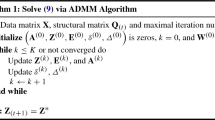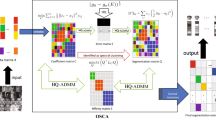Abstract
Recently, the Riemannian manifold has received special attention in unsupervised clustering since the real-world visual data usually resides on a special manifold where Euclidean geometry fails to capture. Although many clustering algorithms have been proposed, most of them use only a single geometric model to describe the data. In this paper, a multi-geometric subspace clustering model is proposed, and the subspace representation is learned together by constructing a shared affinity matrix of multi-order data. Experimental results on several different types of datasets show that the clustering performance of our proposed algorithm is better than most of subspaces algorithms.





Similar content being viewed by others
Explore related subjects
Discover the latest articles, news and stories from top researchers in related subjects.References
Tsakiris MC, Vidal R (2017) Algebraic clustering of affine subspaces. Algebraic Clustering of Affine Subspaces 40:482–489
Ji P, Salzmann M, Li H (2015) Shape interaction matrix revisited and robustified: efficient subspace clustering with corrupted and incomplete data. In: Proceedings of the IEEE international conference on computer vision, pp 4687–4695
Gruber A, Weiss Y (2004) Multibody factorization with uncertainty and missing data using the EM algorithm. In: Proceedings of the IEEE computer society conference on computer vision and pattern recognition
Rao SR, Tron R, Vidal R (2008) Motion segmentation via robust subspace separation in the presence of outlying, incomplete, or corrupted trajectories. In: IEEE conference on computer vision and pattern recognition
Elhamifar E, Vidal R (2013) Sparse subspace clustering: algorithm, theory, and applications. IEEE Trans Pattern Anal Mach Intell 35(11):2765–2781
Liu G, Lin Z, Yan S (2012) Robust recovery of subspace structures by low-rank representation. IEEE Trans Pattern Anal Mach Intell 35(1):171–184
Favaro P, Vidal R, Ravichandran A (2011) A closed form solution to robust subspace estimation and clustering. In: IEEE conference on computer vision and pattern recognition
Hu H, Lin Z, Feng J (2014) Smooth representation clustering. In: Proceedings of the IEEE conference on computer vision and pattern recognition, pp 3834–3841
Li CG, You C, Vidal R (2017) Structured sparse subspace clustering: a joint affinity learning and subspace clustering framework. IEEE Trans Image Process 26(6):2988–3001
Ji P, Zhang T, Li H (2017) Deep subspace clustering networks. In: Advances in neural information processing systems, pp 24–33
Dong W, Wu XJ, Kittler J (2019) Sparse subspace clustering via nonconvex approximation. Pattern Anal Appl 22(1):165–176
Rao S, Tron R, Vidal R (2009) Motion segmentation in the presence of outlying, incomplete, or corrupted trajectories. IEEE Trans Pattern Anal Mach Intell 32(10):1832–1845
Otto C, Wang D, Jain AK (2017) Clustering millions of faces by identity. IEEE Trans Pattern Anal Mach Intell 40(2):289–303
Shi Y, Otto C, Jain AK (2018) Face clustering: representation and pairwise constraints. IEEE Trans Inf Forensics Secur 13(7):1626–1640
You C, Robinson D, Vidal R (2016) Scalable sparse subspace clustering by orthogonal matching pursuit. In: Proceedings of the IEEE conference on computer vision and pattern recognition, pp 3918–3927
Kang Z, Pan H, Hoi SCH (2019) Robust graph learning from noisy data. IEEE Trans Cybern 50(5):1833–1843
Nie F, Wang X, Huang H (2014) Clustering and projected clustering with adaptive neighbors. In: Proceedings of the 20th ACM SIGKDD international conference on knowledge discovery and data mining, pp 977–986
Patel VM, Vidal R (2014) Kernel sparse subspace clustering. In: Proceedings of the IEEE conference on computer vision and pattern recognition, pp 2849–2853
Yin M, Guo Y, Gao J (2016) Kernel sparse subspace clustering on symmetric positive definite manifolds. In: Proceedings of the IEEE conference on computer vision and pattern recognition, pp 5157–5164
Liu T, Shi Z, Liu Y (2017) Visual Clustering based on Kernel Sparse Representation on Grassmann Manifolds. In: IEEE 7th annual international conference on CYBER technology in automation, control, and intelligent systems (CYBER), pp 920–925
Shirazi S, Harandi MT, Sanderson C (2012) Clustering on Grassmann manifolds via kernel embedding with application to action analysis. In: IEEE international conference on image processing, pp 781–784
Wang B, Hu Y, Gao J (2014) Low rank representation on Grassmann manifolds. In: Asian conference on computer vision, pp 81–96
Liu T, Shi Z, Liu Y (2018) Kernel sparse representation on Grassmann manifolds for visual clustering. Opt Eng 57(5):053–104
Brbić M, Kopriva I (2018) Multi-view low-rank sparse subspace clustering. Pattern Recognit 73:247–258
Zhang X, Sun H, Liu Z (2019) Robust low-rank kernel multi-view subspace clustering based on the Schatten p-norm and correntropy. Inf Sci 477:430–447
Gao H, Nie F, Li X (2015) Multi-view subspace clustering. In: Proceedings of the IEEE international conference on computer vision, pp 4238–4246
Zhang Z, Liu L, Shen F (2018) Binary multi-view clustering. IEEE Trans Pattern Anal Mach Intell 41(7):1774–1782
Kang Z, Zhao X, Peng C (2020) Partition level multiview subspace clustering. Neural Netw 122:279–288
Kang Z, Shi G, Huang S (2020) Multi-graph fusion for multi-view spectral clustering. Knowl Based Syst 189:105–102
Arsigny V, Fillard P, Pennec X (2007) Geometric means in a novel vector space structure on symmetric positive-definite matrices. SIAM J Matrix Anal Appl 29(1):328–347
Arsigny V, Fillard P, Pennec X (2005) Fast and simple computations on tensors with log-Euclidean metrics. INRIA
Arsigny V, Fillard P, Pennec X (2006) Log-Euclidean metrics for fast and simple calculus on diffusion tensors. Magn Resonance Med 56(2):411–421
Pennec X, Fillard P, Ayache N (2006) A Riemannian framework for tensor computing. Int J Comput Vis 66(1):41–66
Field DJ (1987) Relations between the statistics of natural images and the response properties of cortical cells. JOSA A 4(12):2379–2394
Wang R, Guo H, Davis L S (2012) Covariance discriminative learning: a natural and efficient approach to image set classification. IEEE conference on computer vision and pattern recognition, pp 2496–2503
Schölkopf B, Smola AJ, Bach F (2002) Learning with kernels: support vector machines, regularization, optimization, and beyond. MIT Press, Cambridge
Lu J, Wang G, Moulin P (2013) Image set classification using holistic multiple order statistics features and localized multi-kernel metric learning. In: Proceedings of the IEEE international conference on computer vision, pp 329–336
Gönen M, Alpaydin E (2008) Localized multiple kernel learning. In: Proceedings of the 25th international conference on machine learning, pp 352–359
Kang Z, Peng C, Cheng Q (2017) Twin learning for similarity and clustering: a unified kernel approach. In: Thirty-first AAAI conference on artificial intelligence
Kang Z, Peng C, Cheng Q (2018) Unified spectral clustering with optimal graph. In: Thirty-second AAAI conference on artificial intelligence
Kang Z, Wen L, Chen W (2019) Low-rank kernel learning for graph-based clustering. Knowl Based Syst 163:510–517
Wang R, Guo H, Davis LS (2012) Covariance discriminative learning: a natural and efficient approach to image set classification. In: Proceedings of the IEEE conference on computer vision and pattern recognition
Wang R, Wu X-J, Chen K-X, Kittler J (2020) Multiple Riemannian manifold-valued descriptors based image set classification with multi-kernel metric learning. IEEE Trans Big Data. https://doi.org/10.1109/TBDATA.2020.2982146
Jayasumana S, Hartley R, Salzmann M (2013) Kernel methods on the Riemannian manifold of symmetric positive definite matrices. In: Proceedings of the IEEE conference on computer vision and pattern recognition, pp 73–80
Boyd S, Parikh N, Chu E (2010) Distributed optimization and statistical learning via the alternating direction method of multipliers. Found Trends Mach Learn 3(1):1–122
Donoho DL (1995) De-noising by soft-thresholding. IEEE Trans Inf Theory 41(3):613–627
Daubechies I, Defrise M, De Mol C (2004) An iterative thresholding algorithm for linear inverse problems with a sparsity constraint. Commun Pure Appl Math 57(11):1413–1457
Ng AY, Jordan MI, Weiss Y (2001) On spectral clustering: analysis and an algorithm. In: International conference on neural information processing systems: natural and synthetic
Schütze H, Manning C D, Raghavan P (2008) Unified spectral clustering with optimal graph. International communication of association for computing machinery conference
Samaria FS, Harter AC (1994) Parameterisation of a stochastic model for human face identification. In: Proceedings of IEEE workshop on applications of computer vision, pp 138–142
Nene SA, Nayar SK, Murase H (1996) Columbia object image library (COIL-100). Technical Report CUCS-006-96
Acknowledgements
The work is supported by the National Natural Science Foundation of China (Grant Nos. 61672265, U1836218), the 111 Project of Ministry of Education of China (Grant No. B12018).
Author information
Authors and Affiliations
Corresponding author
Additional information
Publisher's Note
Springer Nature remains neutral with regard to jurisdictional claims in published maps and institutional affiliations.
Rights and permissions
About this article
Cite this article
Hu, WB., Wu, XJ. Multi-geometric Sparse Subspace Clustering. Neural Process Lett 52, 849–867 (2020). https://doi.org/10.1007/s11063-020-10274-z
Published:
Issue Date:
DOI: https://doi.org/10.1007/s11063-020-10274-z




